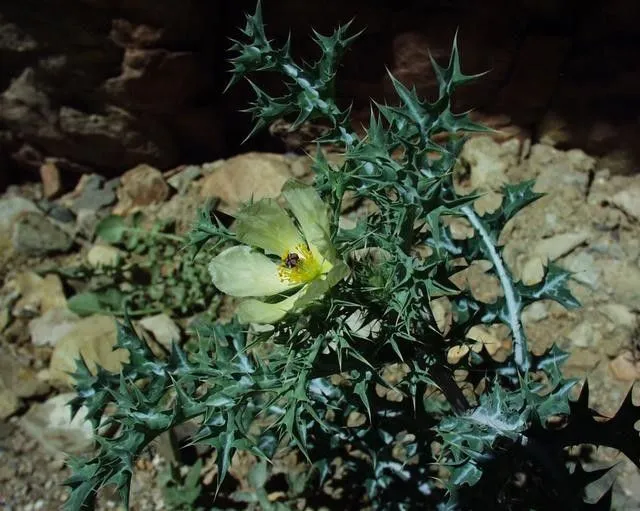
Author: Sweet
Bibliography: Brit. Fl. Gard. 3: t. 242 (1828)
Year: 1828
Status: accepted
Rank: species
Genus: Argemone
Vegetable: False
Observations: Mexico
The White-flower Mexican Poppy, scientifically known as Argemone ochroleuca, is a striking member of the Papaveraceae family. It was first documented in a detailed description by Sweet in 1828 as part of “Brit. Fl. Gard. 3: t. 242,” and its origins can be traced back to the vibrant and diverse landscapes of Mexico.
This hardy perennial is notable for its distinctive white to creamy-tinged blossoms, which have a delicate, ephemeral quality that contrasts beautifully with the rugged, thorny leaves and stems characteristic of the species. The flowers typically feature a central cluster of bright yellow stamens, creating a striking focal point that attracts a variety of pollinators.
The White-flower Mexican Poppy thrives in dry, arid environments, which is a testament to its adaptability and resilience. It is commonly found growing in sandy soils, often in areas that receive full sunlight, making it a robust participant in the diverse tapestry of Mexico’s native flora. The plant’s ability to flourish in such challenging conditions highlights both its enduring beauty and ecological significance.
Argemone ochroleuca plays a functional role within its ecosystem, providing sustenance and habitat for local wildlife. Despite its somewhat prickly exterior, it can serve as a food source for certain insects and birds, making it an integral part of the biological community. Additionally, its presence within the landscape contributes to the stabilization of soil, preventing erosion and fostering a more balanced ecosystem.
In terms of cultural and historical significance, the White-flower Mexican Poppy has been recognized and recorded for nearly two centuries. Its enduring appeal isn’t solely due to its aesthetic qualities but also its botanical intrigue, making it a subject of interest for botanists and plant enthusiasts alike since the early days of its recorded history.
Overall, Argemone ochroleuca stands as a remarkable example of nature’s adaptability and beauty. Its striking appearance and ecological contributions make it a valuable study subject for understanding plant resilience and the intricate balance of natural ecosystems, particularly in arid and semi-arid regions like those found in Mexico.
Eng: mexican-poppy, pale mexican pricklypoppy, pale mexican-poppy, prickly-poppy, white-flower mexican-poppy
Spa: chicalote
Afr: witblom-bloudissel
En: White-flower Mexican-poppy, Pale Mexican-poppy, Mexican-poppy, Prickly-poppy, Pale Mexican pricklypoppy, Mexican poppy, Mexican Pricklypoppy
Af: Witblom-bloudissel
Ar: أرجمون أصفر
Zh: 淡黄蓟罂粟
Nl: Stekelpapaver
Fr: Argémone
Es: Chicalote, Amapola espinosa
Zh-tw: 淡黃薊罌粟
: Pale mexican pricklypoppy
Taken Sep 5, 2020 by Michael Luck (cc-by-sa)
Taken Jan 12, 2020 by Ricord John (cc-by-sa)
Taken Mar 2, 2020 by Sacha Parkinson (cc-by-sa)
Taken Feb 8, 2022 by SEYNI HAMANI Mohamed Djafarou (cc-by-sa)
Taken Oct 19, 2020 by Dele Ste (cc-by-sa)
Taken Apr 16, 2021 by tonatiuh_1 (cc-by-sa)
Taken Nov 8, 2020 by Onkabetse Gaolatlhe Kesetse (cc-by-sa)
Taken Nov 18, 2008 by Tela Botanica − Liliane ROUBAUDI (cc-by-sa)
Taken Feb 2, 2015 by Tela Botanica − Louise Boulangeat (cc-by-sa)
Taken Nov 23, 2022 by Sam Jones (cc-by-sa)
Taken Dec 24, 2020 by Shehadi Ramiz (cc-by-sa)
Taken Nov 18, 2008 by Tela Botanica − Liliane ROUBAUDI (cc-by-sa)
Taken Nov 18, 2008 by Tela Botanica − Liliane ROUBAUDI (cc-by-sa)
Taken Feb 2, 2015 by Tela Botanica − Louise Boulangeat (cc-by-sa)
© copyright of the Board of Trustees of the Royal Botanic Gardens, Kew.
© copyright of the Board of Trustees of the Royal Botanic Gardens, Kew.
© copyright of the Board of Trustees of the Royal Botanic Gardens, Kew.
Growth habit>: Forb/herb
Family: Myrtaceae Author: (F.Muell.) K.D.Hill & L.A.S.Johnson Bibliography: Telopea 6: 402 (1995) Year: 1995 Status:…
Family: Rubiaceae Author: Pierre ex A.Froehner Bibliography: Notizbl. Bot. Gart. Berlin-Dahlem 1: 237 (1897) Year:…
Family: Sapindaceae Author: Koidz. Bibliography: J. Coll. Sci. Imp. Univ. Tokyo 32(1): 38 (1911) Year:…
Family: Asteraceae Author: A.Gray Bibliography: Pacif. Railr. Rep.: 107 (1857) Year: 1857 Status: accepted Rank:…
Family: Fabaceae Author: Medik. Bibliography: Vorles. Churpfälz. Phys.-Ökon. Ges. 2: 398 (1787) Year: 1787 Status:…
Family: Aspleniaceae Author: (Cav.) Alston Bibliography: Bull. Misc. Inform. Kew 1932: 309 (1932) Year: 1932…